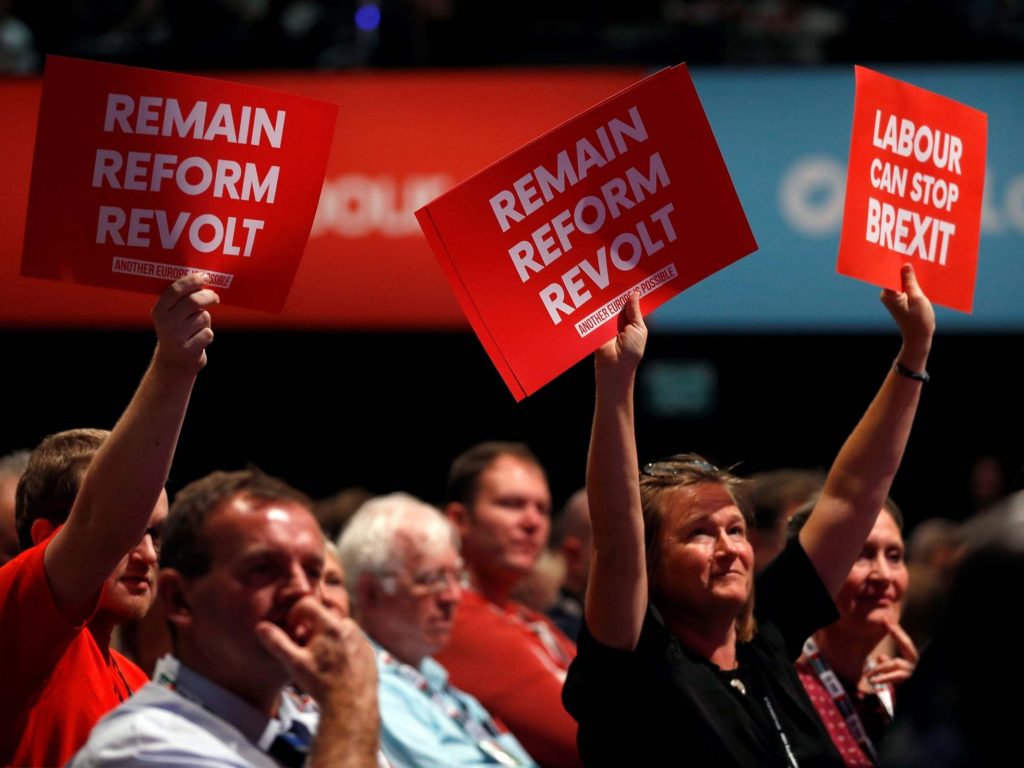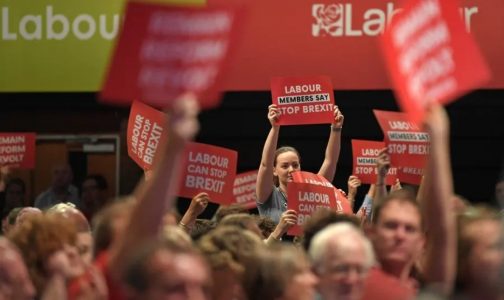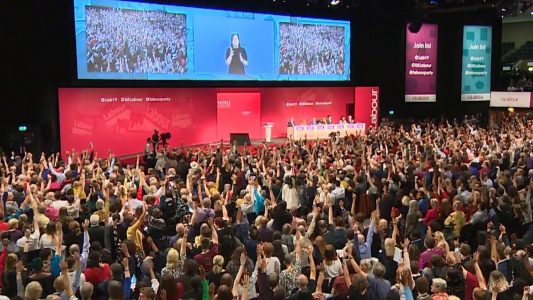Standing back and looking objectively at the evolution of Labour’s Brexit policy, it is difficult not to do a double-take. Coming out of the Labour conference 2018, anti-Brexit activists felt positive about having pushed the party into including a public vote as a prominent option. Going into conference 2019, we had already won Labour to backing a public vote with a Remain option in all circumstances, leaving only the question of which Brexit outcome Labour preferred.
As the organisation leading the anti-Brexit campaign ahead of the conference, Another Europe arrived in Brighton with two primary policy aims. Firstly, to secure a binding guarantee that Labour would back Remain in any future public vote. Secondly, to win Labour over to a radical immigration policy, including support for free movement and giving the vote to all migrants.
In the end, we were defeated on one vote but won the other – and gained concessions along the way. This is an overview of what happened.
The backdrop and buildup
The past few months have brought a certain sharpness and clarity to Labour’s internal Brexit debate. The party’s dire performance in the European elections – where it lost three or four Remainers for every one Leaver – informed the leadership’s shift in policy. And Boris Johnson’s rise to power has brought the Brexit project to its logical, and hard right, conclusion. The conference took place in the immediate aftermath of the massive #StopTheCoup protests, which we had helped to coordinate.
Ahead of the conference, Another Europe ran another big campaign to get motions through CLPs and sent to conference. Phonebanks were in operation from June. Altogether, around 90 motions were submitted on Brexit, the vast majority of them Remain ones written by us or other Remain groups. And over the course of the previous year, hundreds of CLPs had passed Remain policy.
Arriving in Brighton, we knew that the odds were stacked against us, with the bulk of the party machine determined to hold together the position agreed by the unions a couple of weeks earlier. But despite having just worked non-stop organising the #StopTheCoup protests – and not knowing until the last minute if the conference would even happen – we also managed to arrive relatively well prepared. We had a well worked out operation among delegates, a large amount of propaganda, five planned fringe meetings, and an army of volunteers.
We had also built a broad coalition – incorporating Labour for a Socialist Europe, Open Labour, Remain Labour and Labour for a Public Vote as well as ourselves.
The motions, the chaos, the manoeuvres
We arrived on Friday determined to take a clear Remain stance all the way to the conference floor, and that is exactly what we did – despite the at times surreal events of the next few days.
On Friday evening, it became clear that the leadership was not going to allow members to draft Labour’s policy through the motions process. Most of the press that evening was taken up with the absurd (and quickly aborted) spectacle of Jon Lansman moving to literally delete Tom Watson from the Labour constitution. But the real story came the following morning, when the NEC was presented with an NEC Statement (in effect a motion) on Brexit.
The NEC position was a fudge – committing Labour to back a public vote but only to decide which way to campaign after a general election, by holding a one day special conference on the subject. Initially unable to get this through an actual meeting of the NEC, the leadership decided instead to put the Statement out to an email vote. No amendments were voted on, no debate was had, and many NEC members didn’t know the vote was happening. The Chair of the NEC at various points ruled that this situation was unconstitutional, but went unheeded.
Running parallel to the NEC statement farago was the actual motions process. Compositing – the process by which motions are brought together into a single text – took place on Sunday night. Keeping your motion intact through this process is extremely difficult, and our operation relied on constant communication and daily briefing meetings with all of the delegates going into the meeting. We arrived at the compositing room to find that Jon Trickett, a prominent opponent of the push for a public vote, had been inexplicably airlifted onto the top table, sitting alongside Keir Starmer. Our motion did come out as planned, but not without a handful of CLPs splitting off and putting forward their own opposing motion.
All of this meant that, on Monday afternoon, three motions were set to go to the vote. The first was the NEC Statement fudge, promising neutrality for now but a special conference after the election. The second (“Composite 13”) committed Labour to backing Remain in any public vote. The third (“Composite 14”) praised the leadership’s handling of Brexit and said little about the policy.
Behind the scenes, things were moving. Unison, the biggest union on conference floor, moved to back Remain and oppose the NEC statement. USDAW, the shop workers’ union, eventually came with them, along with the Musicians’ Union and the white collar transport union TSSA.
As things shifted, the party management machine pulled out all the stops to defeat us. Momentum had always agreed to remain studiously neutral on Labour’s Brexit debate, knowing that its membership largely backed Remain. But on the Monday morning of conference, a small group of its ruling body (the Officers’ Group of its NCG) held a phone meeting, and, under heavy pressure from the leadership, whipped its delegates to oppose the Remain motion and back the NEC.
The vote
By the time of the votes on Monday afternoon, the narrative around the Brexit debate had been teed up: either you were loyal to the leadership and the left, or you backed a Remain stance. Rather than hedge its bets under threat of defeat, the leadership went all in – holding up the NEC statement as “Jeremy Corbyn’s Brexit policy”. For those of us who had brought the Remain motion, many of us having had spent years fighting for the left in Labour and seeing a Remain stance as Corbyn’s best path to power, this was galling.
What followed from the rostrum was less a series of speeches and more a talented display of gymnastics. Many of the opponents of the Remain motion had, until recently, opposed any path to stopping Brexit. And yet here they were, apparently emotionally attached to the new line of a public vote. While our speakers plugged away with left wing speeches arguing that without a clear position Labour might well lose an election, the other side’s key message was “neither the 52% nor the 48%, but the 99%, and by the way: Jeremy Corbyn.” Not really a response to our arguments, but effective rhetoric on a conference floor marked by loyalism.
Amid dramatic scenes, with the chair of conference refusing to count the votes, the Remain motion was declared lost by a show of hands. From the balcony, it looked probable that we had lost the overall vote, but probably won a majority of the CLP delegates (i.e. members’ reps at the conference). Without the card vote, we’ll never know.
Explaining defeat
We always knew that defeat was the most likely option, if the opposition stood firm; they knew this too, which is probably why they did. Despite Unison backing us, a big majority of the union bloc votes were pledged to the NEC position. The unions count for 50% of the total and were stacked against us, so we needed to win big in the CLPs.
With Momentum whipping against us, a united front was presented between it, the majority of the unions and the leadership. Delegations bent and broke under the pressure. We are still trying to get a handle on the number of CLP delegates who broke their mandate – who voted against a Remain position despite being sent to conference to vote for one – but it was probably a decisive factor.
We could, and did, protest that real loyalty is about doing what is best for the left, not just doing what you’re told. We could shout to the rafters about the record of our campaigners in backing the left, in winning industrial disputes, in putting themselves on the line to fight injustice. But the other side had a louder voice, and, for all our organising efforts, a stronger line of communication with a certain layer of delegates.
What did we achieve?
We lost, but we also won.
First, it should be noted that the policy passed by conference contained significant steps forward – above and beyond the public vote which we had already won. We got a stated time limit of six months between Labour’s election and a public vote, and the promise of a democratic route (a special conference) to determining Labour’s final position.
Second, the act of properly pushing to a vote on Remain meant that our opponents were distracted and had to use all of their capital defeating us on Monday afternoon. This gave our other key aim of conference – free movement – a much easier ride on Wednesday morning. The result is that Labour has the most radical immigration policy in its history – including defending and extending free movement, shutting down all detention centres, ending no recourse to public funds, and giving migrants the vote.
Third, we dragged the debate even further in our direction. Going into conference, backing a public vote was a clear commitment from the leadership but not, for many within it, one to which they held with much gusto. To win, those who opposed Remain had to actively fight for the public vote position, arguing for it from the rostrum and getting their delegates behind it. We watched on as the Lexit faction became the second referendum faction.
Fourth, we did something positive about the democratic culture of Labour conference. The party management ethos seeks to avoid contested votes on the floor, preferring to fudge controversial issues behind closed doors. We showed that Labour members can propose motions, take their policy to conference, and lose if they have to. Long may that continue.
A final word on the leadership
Another Europe did, of course, hold meetings with the Leader’s Office before and during conference in the hope of finding a compromise. The meetings were good-natured and the discussions were genuine – and I won’t disclose exactly what was discussed.
But I do think that it is worth reporting one thing, from the various conversations we’ve had. It is the genuinely held belief of the dominant faction within the Labour leadership that Labour’s route to winning an election is with its current policy. This is not a belief which is informed by data or polling evidence, but by a logic: that the best way to move the conversation on from Brexit in an election is not to take sides on it. Their hunch is, I think, that the dynamics of 2017 can simply be repeated.
For those who backed the Remain motion at conference, our task in the coming election will not just be to hope that we are wrong, but to spend every waking moment trying to prove ourselves wrong.
Labour is, for all the flaws in its position, now offering a clear route to Remain. If a general election happens, any rational voter will know: the only way to stop Brexit is for Jeremy Corbyn’s Labour Party to beat the Tories and form a government. Let’s hope that the voters are rational, and that Labour’s shift has not come too late.
1st October 2019



